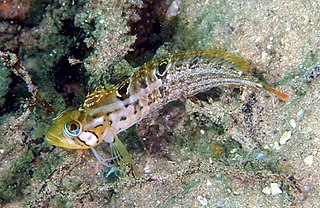
The checkerboard wrasse is a fish belonging to the wrasse family. It is native to the area including the Indian Ocean to central Pacific Ocean.

Epinephelus andersoni, the catface grouper, brown-spotted grouper, catface rockcod or brown spotted rockcod, is a species of marine ray-finned fish, a grouper from the subfamily Epinephelinae which is part of the family Serranidae, which also includes the anthias and sea basses. It is found in the southwestern Indian Ocean where it is associated with reefs.

Halichoeres are a genus of wrasses found in the Atlantic, Indian and Pacific Oceans.
Pseudanthias heemstrai, the orange-headed anthias, Heemstra's anthias or redhead anthias is a species of marine ray-finned fish in the genus Pseudanthias, the subfamily Anthiinae of the family Serranidae, the groupers and sea basses. It is endemism to the Red Sea. It occasionally makes its way into the aquarium trade. It grows to a size of 13 cm in length.

Bellator egretta, the streamer searobin, is a species of marine ray-finned fish belonging to the family Triglidae, the sea robins. This fish is found in the western Atlantic Ocean.

Clinus agilis, the agile klipfish, is a species of clinid found in subtropical waters of the Atlantic Ocean from Namibia to South Africa where it is commonly found in estuaries and tide pools. This species can reach a maximum length of 10 centimetres (3.9 in).

Clinus venustris, the speckled klipfish, is a species of clinid that occurs in subtropical waters of the Atlantic Ocean from Namibia to South Africa where it is found in the subtidal zone as well as being a denizen of tide pools. This species can reach a maximum length of 12 centimetres (4.7 in) TL. and feeds primarily on amphipods, isopods, mysids, and echinoderms.

The yellowhead wrasse is a fish species belonging to wrasse family native to shallow tropical waters in the Caribbean Sea and western Atlantic Ocean.
The yellowmouth grouper, also known as the crossband rockfish, grey mannock, hamlet, harlequin rockfish, princess rockfish, rockfish, salmon grouper, salmon rock fish or scamp, is a species of marine ray-finned fish, a grouper from the subfamily Epinephelinae which is part of the family Serranidae, which also includes the anthias and sea basses. It is found in the Caribbean and in the tropical waters of the Atlantic Ocean. It is also found in pockets in Brazil. It is a fairly large fish and it gets its name from the yellow around its mouth.

Halichoeres maculipinna, the clown wrasse, is a species of tropical fish that lives throughout the Caribbean Sea and adjacent parts of the western Atlantic Ocean. It is a carnivorous, multi-colored wrasse that is common throughout its range.

Epinephelus epistictus, the dotted grouper, black-dotted rock-cod, black-spotted grouper, broken-line grouper or spottedback grouper, is a species of marine ray-finned fish, a grouper from the subfamily Epinephelinae which is part of the family Serranidae, which also includes the anthias and sea basses. This species is found in the Indo-Pacific where its distribution ranges form the Red Sea to Australia and Japan. The dotted grouper may grow up to 70–80 cm length. It is a demersal fish found at 70–300 m depths.

Iniistius pavo, the peacock wrasse or blue razorfish, is a species of marine ray-finned fish from the family Labridae, the wrasses, which has a wide Indo-Pacific distribution.

Halichoeres richmondi, commonly called the Richmond's wrasse or chain-lined wrasse, is a fish species in the wrasse family native from the central Indo-Pacific.

Jaydia queketti, the spotfin cardinal or signal cardinalfish, is a species of ray-finned fish from the Indian Ocean, it is a member of the family Apogonidae. It has colonised the eastern Mediterranean Sea by way of the Suez Canal since 2004.

The blackear wrasse is a species of wrasse, a type of fish in the family Labridae, from the warmer waters of the western Atlantic Ocean.
Trachurus delagoa, the African scad, is a species of jack mackerel from the family Carangidae which is found in the south western Indian Ocean.

The bleeding wrasse is a species of marine ray-finned fish from the family Labridae, the wrasses. It is found in reefs in the eastern central Pacific Ocean.

Pseudocoris heteroptera, the torpedo wrasse or zebra wrasse, is a species of marine ray-finned fish, a wrasse from the family Labridae. It is found in the western Pacific Ocean where it is associated with reefs.

Pteragogus trispilus is a species of marine ray-finned fish from the wrasse family, the Labridae. It is native to the Red Sea from where it has entered the Mediterranean Sea.
Bambradon is a monotypic genus of marine ray-finned fish belonging to the family Bembridae, the deepwater flatheads. Its only species, Bambradon laevis, is found in the northwestern Pacific Ocean off Japan.
















